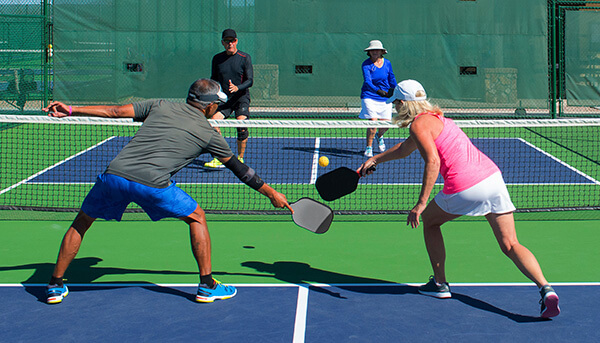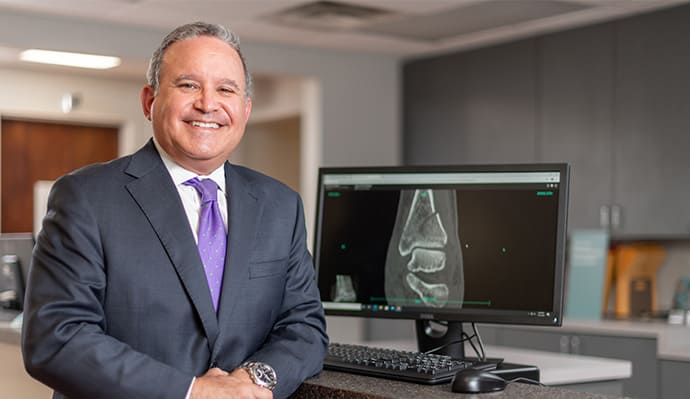 Pickleball’s popularity had taken off since the pandemic with many participants surprised to learn the sport has been around for nearly 60 years. What is also surprising is the number of people getting hurt while playing.
Pickleball’s popularity had taken off since the pandemic with many participants surprised to learn the sport has been around for nearly 60 years. What is also surprising is the number of people getting hurt while playing.
The appeal of the sport is that it is low impact and easy to learn so it is attractive to the 55 and older population. However, because it requires quick movement and agility as well as balance and strength, injuries have been occurring within this population at a rapid rate.
Towson Orthopaedic Associates has asked some of our specialists to outline the types of injuries they are seeing and tips for injury prevention. We’ve broken down the tips by parts of the body most impacted by injury.
Knee Injuries
What types of knee injuries are you seeing?
Knee sprains, muscle strains – including quadriceps and hamstrings – and meniscal injuries are all common injuries in pickleball.
Players may also suffer flare-ups of their underlying arthritis.
How are these injuries best treated?
Knee sprains and muscle strains are typically treated RICE – rest, ice, compression and elevation. Anti-inflammatories (such as Advil, Ibuprofen, Aleve) can also be taken to help alleviate the pain.
Meniscal injuries are often treated similarly, but may also need an injection. Occasionally with persistently painful meniscal tears, minimally invasive (arthroscopic) surgery could be required.
Exacerbations of arthritis can also be treated with injections. When the arthritis has become severe and pain is not managed with the above strategies, a knee replacement may be recommended.
What can I do to avoid a knee injury?
Warming up and stretching is very important. Strengthening thigh muscles – including quadriceps, hamstrings – in addition to our hip musculature, can also help in protection of the joint.
When returning from an injury, occasionally a brace may be recommended to give the knee additional support and compression to avoid reinjury.
Hand, Wrist, Elbow, & Shoulder Injuries
What types of injuries are you seeing?
Upper extremity injuries related to pickleball are evaluated in our practice here at Towson Orthopedic Associates weekly. Weiss, et. al,2021, published an article tracking non-fatal pickleball and tennis injuries in the US between 2010-2019 and found through a survey of injuries evaluated at U.S. Emergency departments, a 21.5% increase in ER visits for pickleball related injuries. Most injuries fall into the category of “Slip/Trip/Fall/Dive” according to the authors.
Just as we have seen a rise in “texting thumb” over the years, there is now a condition referred to as “pickleball elbow” (Journal of Epidemiology, 2021). “Pickleball elbow”, otherwise known as “tennis elbow” or lateral epicondylitis can be treated, and may resolve through stretching, protecting the tendon/elbow, and returning to play when symptoms abate.
Acute wrist injuries are the most common complaints. They occur while tripping and reaching with an outstretched hand to break a fall. The wrist injuries that are sustained range from a sprain to a fracture. Colles fracture of the wrist is the most common injury that may sometimes require surgical correction in a pickleball injury.
Other areas of the upper extremity that can be injured by way of a fall include the elbow and shoulder including fracture or tendon tears.
A pickleball player can also sustain injury to fingers and hand including sprains, strains and fractures.
What can I do to avoid these injuries?
The importance of preparation, including balance and stamina, may decrease the risk of injuries while enjoying a day on the courts.
The ability to be balanced and steady while playing can benefit from engaging in Tai Chi, biking, elliptical, walking and swimming to create a strong core and increase stamina needed to play this ever-popular game.
Ankle Injuries
What types of injuries are you seeing?
The most common pickle ball injury I see is Achilles tendon tears or ruptures.
The typical patient is playing for the first time, although experienced players have also sustained these injuries. The player will take a quick step on the court and feel pain in the back of their ankle and often hear a pop and have difficulty walking.
It is important to get seen by someone experienced in the treatment of these injuries as quickly as possible, hopefully within a couple of days of the injury.
How are these injuries treated?
If seen by an Orthopaedic Foot and Ankle specialist, we can quickly place the patient into an appropriate splint or boot and place them on crutches.
Further treatment is determined by the patient’s overall medical conditions, and desired activity level going forward.
– If a continued high level of activity is desirable then surgical repair is usually recommended.
– If lower levels of activity are planned and avoiding sprinting, cutting and jumping sports, then we can consider non-operative treatment.
With either treatment, patients can expect the overall recovery to last up to 9-12 months.
What can I do to avoid an ankle injury?
The best way to avoid getting injured is to do lots of stretching of the calf muscles and hamstrings prior to playing pickle ball and begin warming up slowly on the court.
Hip Injuries
What are some of the typical hip injuries?
The most common hip injuries from pickleball are muscle strains of the gluteal, hip flexor or hamstring muscles. Labral tears and exacerbation of underlying hip arthritis can also occur.
How they are treated?
Muscle strains are treated with rest, anti-inflammatories and physical therapy to work on stretching and strengthening.
Labral tears are often treated non-operatively with anti-inflammatories, physical therapy and sometimes injections.
Hip arthritis is treated non-operatively if mild to moderate, but if it is severe and recalcitrant to non-operative management a hip replacement can be performed. Most patients are able to get back to playing pickleball after a hip replacement!
What can people do to avoid a hip injury?
People can help prevent hip injuries by stretching prior to playing and working on core, hip and lower extremity strengthening.
Additional Resources
Pickleball is for everyone, but watch the injuries – Catholic Review
References
Pickleball annual growth report. USA Pickleball. (2023, March 10).
Weiss, H., Dougherty, J., & DiMaggio, C. (2021, May 3). Non-fatal senior pickleball and tennis-related injuries treated in United States emergency departments, 2010–2019 – Injury Epidemiology. BioMed Central.
Conti, K. (2022, November 16). Why pickleball players are getting paddled with injuries. NBC New York.
Greiner, N. (2019). Pickleball: Injury considerations in an increasingly popular sport. Missouri medicine.






